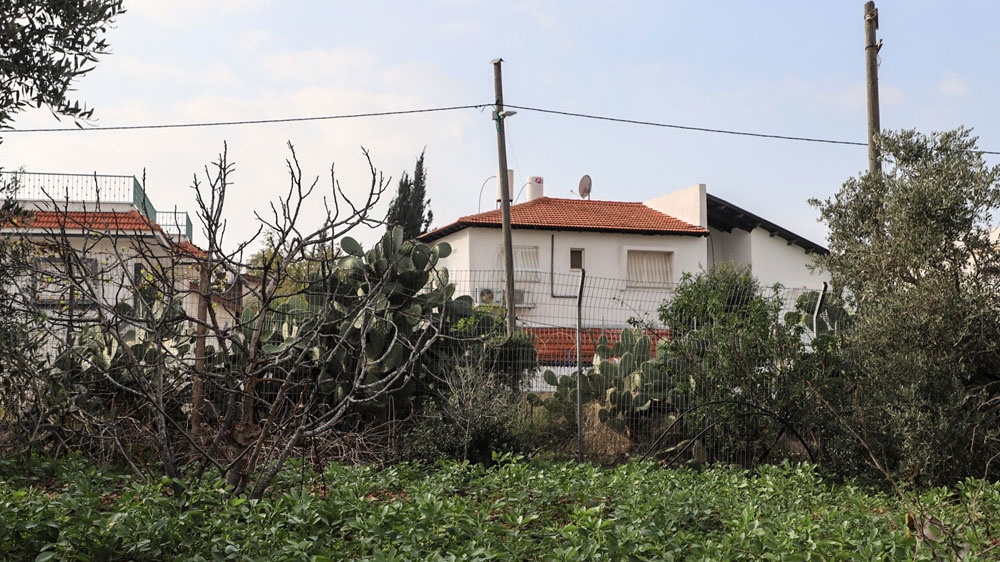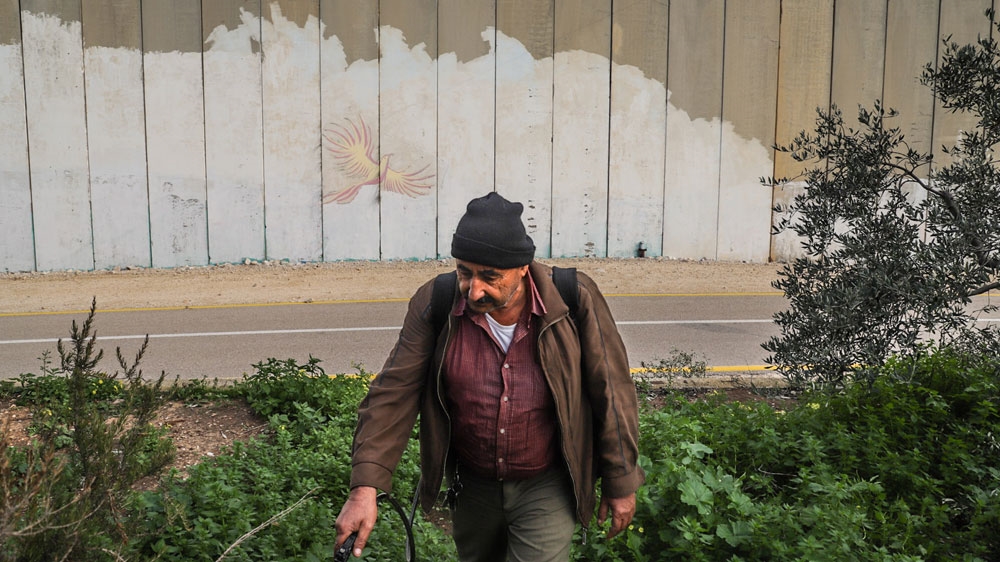The Palestinian home hemmed in by Israel’s separation wall
Salfit, occupied West Bank – A decade and a half ago, Munira Ibrahim Amer would venture outside to the front porch of her home in Mas’ha village each morning and watch her community come alive.
She remembers children giggling and sauntering off to school, the bustling of cars as residents made their way to work, and the fruit and vegetable vendors scrambling to set up their shops for the morning rush.
Nowadays, all Munira is able to see from her porch is a massive concrete wall.
“I somehow got used to it,” Munira, 54, told Al Jazeera. “Feeling the pain every day is too much to handle, so at some point you have to stop feeling.”
Israel established the illegal settlement of Elkana on the outskirts of the village in 1977. It expanded through the decades and is now home to some 3,884 Israelis residing in the occupied West Bank in violation of international law, according to Israeli rights group, B’Tselem.
 |
| Israeli homes in the illegal Elkana settlement in occupied West Bank [Jaclynn Ashly/Al Jazeera] |
In 2002, when Israel began building its separation barrier, declared illegal by the International Court of Justice two years later, the family home near the settlement ended up on the Israeli side of the barrier.
The length of Israel’s wall is expected to be 712km upon its completion, more than double the length of the Green Line, which divides the occupied Palestinian territory and Israel.
 |
| [Courtesy of Dror Etkes] |
According to B’Tselem, 85 percent of the structure’s route, which consists of electronic and barbed wire fencing, ditches, and a 70km-long concrete wall, is built inside the occupied territory and divides Palestinians from their lands.
Israel’s concrete separation wall was constructed directly in front of the Amer family’s home. The fencing borders them on three sides, separating the family from Israeli settler units located just several metres away from their home.
Decades of loss
Before the Elkana settlement, these lands were used by local farmers. “All the residents of the village were farmers and they spent all their time on the lands, especially during the olive harvests,” Hani Amer, Munira’s husband, told Al Jazeera.
“But this past is now extinct,” the 61-year-old said. “People don’t even like to look to this side of the village , because they see the land they lost and can’t access anymore.”
Hani was about 20 years old when the first settlers arrived in the area. When he married and had children, he feared that the settlement’s expansion would push his family out of the area.
 |
| [Courtesy Dror Etkes] |
The family attempted to stop the construction of the wall, and for a month they succeeded when hundreds of local, international and Israeli activists camped outside their home.
However, Israel eventually deployed 500 soldiers and border police officials to the area to suppress the demonstration. The Palestinians and Israelis were arrested, and all the international activists were deported from the country.
Hani was forced to stand by and watch as his flower shop in front of his home was demolished into rubble to make room for the wall and an Israeli military road that runs parallel to it.
The flower shop used to bring in nearly $270 a day for the family.
Their next property to be targeted was a chicken factory, worth an upwards of $100,000. The family owned 500 chickens that would produce around 150 bags of eggs a day, Hani says.
It was only after the factory had already been demolished that Israeli authorities decided to adjust the route of the wall that would have kept his chicken factory on the West Bank side.
Hani’s 11 hectares of land, where he plants cucumbers, tomatoes, potatoes, and various other fruits and vegetables that he sells at local markets, was also targeted by the Israelis for confiscation.
After protesting the decision with the help of human rights organisations, Hani was able to save eight hectares from being consumed by the wall. However, his ability to reach them was severely impeded.
Before the wall, it would take Hani 15 minutes to walk to his land. Now, it takes him three hours to travel around the settlement and the wall to enter his land from the opposite side.
“Now I spend six hours in travel to see my land, so it affects how much we’re able to produce,” Hani said. “Usually I would be working on the land for eight hours a day. But now it’s hard to do that.”
‘They treat you like a criminal’
The wall’s route was initially supposed to pummel through the Amer family’s home. “I told the Israelis that it’s better to kill me than to take my house,” Hani said.
After negotiations between the family and the Israeli army, and with the assistance of human rights groups, they eventually rerouted the wall and built it right in front of their home.
When the separation barrier was built, the army would open the gate connected to the wall for the family for 15 minutes each day.
Later, they constructed a small gate in the barrier for the family to exit and return. The family was given a key, but only members of the family were permitted to enter the premise.
“I didn’t accept this,” Hani told Al Jazeera. “I would smuggle guests in and if I got caught, the army would take the key away from me.”
It took seven years of negotiations for the Amer family to be able to come and go as they please and to be allowed to have guests at their home.
The Amer family’s home, however, is still surrounded by cameras, with a private security company based in the settlement constantly surveilling them and calling the Israeli army if settlers make a complaint or journalists are seen filming or taking pictures around the home.
“They are spying on me all the time, even though I’m not doing anything wrong,” Hani said. “I’m just living my normal life. But they treat you like some kind of a criminal.”
 |
| Hani Amer tends to his small garden in Mas’ha village, with the separation wall at the back [Jaclynn Ashly/Al Jazeera] |
During the planning stages for the separation barrier, Israeli authorities tried to “have the least amount of Palestinians on the west [Israeli] side of the barrier, and most possible Israeli settlers,” Dror Etkes, a researcher for Israeli rights group Kerem Navot, told Al Jazeera.
“This is why there are so many curves and turns in the structure, and it snakes across the West Bank,” he said. “It was designed to include as much vacant land as possible without including the Palestinians.”
“They want to Judaise the West Bank as much as possible.”
B’Tselem has noted that a major factor in determining the route of the separation barrier was the location of the settlements, “thereby laying the groundwork for the de facto annexation of most of the settlements and much land for their future expansion”.
‘No injustice lasts forever’
While life has become easier for the Amer family compared to the first few years of the wall, they still face harassment by the army and settlers.
The settlers used to come to their home every day, Hani says, but now these intrusions have become less frequent.
Nevertheless, “we still feel like we are in danger all the time”.
For Hani, no amount of time can normalise his situation. “I feel the same as how I felt 10 years ago,” he told Al Jazeera. “As long as the wall and the occupation exist, we will always be suffering.”
“I’ll continue my life by surviving,” he said. “I need to keep going. I still have the will to work and survive.”
Munira says its the overwhelming feeling of loneliness which is the most difficult part. Of their six children, only their 18-year-old son lives in the house; others married and moved outside the area.
“I would love for my children and my relatives to be around me,” Munira said. “But because of this situation, it’s impossible.”
“But we know none of this is permanent,” Hani added.
“I have faith that maybe after two days, 10 days or 100 years, this will all go away, because no injustice can last forever.”




